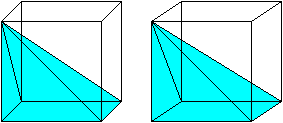It's well known that a cylinder with height $h$ and the base radius $R$ will have a volume of
$$V = \pi R^2h$$
I'm trying to derive an intuitive understanding of it. I have two ways, one seems to be "working" (as in – it yields the correct result) and another one is failing, see below.
Method 1
If we agree that the area of a circle is known as $\pi R^2$ then we can think of a volume as a sum of all "areas of circles along the heights". So if we imagine that there is such an "object" that has a height of "one point" then its volume is equal to the area of the circle it has as a base. We then see that there will be exactly $h$ points in the height of the cylinder, so there will be exactly $h$ such "objects". Hence we can just multiply a "volume" of one "object" by $h$ which will yield the correct cylinder volume. I believe this method is just a "naive" version of a more rigorous calculus approach with defining the limit for $dx$ where $x$ will be along the height of the cylinder
Method 2
Now let's look at the cylinder as a rectangle rotated along one of its sides. If we have $h$ as the cylinder height and $R$ as a radius, then it's an $h \times R$ rectangle rotated by $2\pi$ around the side with length $h$. So the volume is the "sum" of all the "objects" with the height of "one point" and the base a rectangle. There are exactly $2\pi R$ points along the circumference of the circle that the rectangle will follow. Therefore we will have $2\pi R$ of these "objects". So we just need to multiple the "volume" of one such "object" by the number of these "objects" to get the cylinder volume. The "volume" of this "object" will be just the area of a rectangle, since it has a height of "one point". To conclude, we have $2\pi$ of these "objects", thus the volume must be $V = 2\pi R \times V_{\text{object}} = 2\pi R \times h R = 2\pi R^2h$.
But method 2 yields incorrect result, it's exactly $2$ times more than it should be. Why is that? I.e. why is that the point-based construction worked in the first case but failed in the second case? And how to make it work properly? What about rotation in general (i.e. not only a cylinder)?


Best Answer
Well done for trying to get this intuition. The insight comes from calculus. It’s because in your 2nd method, you put too much material near the center.
A better approximation would be to use triangles (they are pointy at one end, and that point belongs near the center of the cylinder). Triangles’ areas are half that of the rectangle with same height and base, so that’s why you overestimated by a factor of two in the second method.
More rigorously, the area element in polar coordinates is $r \ dr \ d\theta$. You should let me know how much exposure to calculus before I explain further.